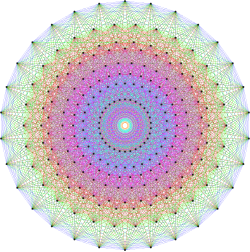Real form (Lie theory)
| Lie groups and Lie algebras |
|---|
 |
In
The notion of a real form can also be defined for complex
Real forms for Lie groups and algebraic groups
Using the
Classification
Just as complex semisimple Lie algebras are classified by Dynkin diagrams, the real forms of a semisimple Lie algebra are classified by Satake diagrams, which are obtained from the Dynkin diagram of the complex form by labeling some vertices black (filled), and connecting some other vertices in pairs by arrows, according to certain rules.
It is a basic fact in the structure theory of complex
Suppose that g0 is a semisimple Lie algebra over the field of real numbers. By Cartan's criterion, the Killing form is nondegenerate, and can be diagonalized in a suitable basis with the diagonal entries +1 or −1. By Sylvester's law of inertia, the number of positive entries, or the positive index of inertia, is an invariant of the bilinear form, i.e. it does not depend on the choice of the diagonalizing basis. This is a number between 0 and the dimension of g which is an important invariant of the real Lie algebra, called its index.
Split real form
A real form g0 of a finite-dimensional complex semisimple Lie algebra g is said to be split, or normal, if in each Cartan decomposition g0 = k0 ⊕ p0, the space p0 contains a maximal abelian subalgebra of g0, i.e. its Cartan subalgebra. Élie Cartan proved that every complex semisimple Lie algebra g has a split real form, which is unique up to isomorphism.[1] It has maximal index among all real forms.
The split form corresponds to the Satake diagram with no vertices blackened and no arrows.
Compact real form
A real Lie algebra g0 is called
The compact form corresponds to the Satake diagram with all vertices blackened.
Construction of the compact real form
In general, the construction of the compact real form uses structure theory of semisimple Lie algebras. For
Let g0 be a real Lie algebra of matrices over R that is closed under the transpose map,
Then g0 decomposes into the direct sum of its skew-symmetric part k0 and its symmetric part p0. This is the Cartan decomposition:
The complexification g of g0 decomposes into the direct sum of g0 and ig0. The real vector space of matrices
is a subspace of the complex Lie algebra g that is closed under the commutators and consists of
See also
Notes
- ^ Helgason 1978, p. 426
References
- Helgason, Sigurdur (1978), Differential geometry, Lie groups and symmetric spaces, Academic Press, ISBN 0-12-338460-5
- Knapp, Anthony (2004), Lie Groups: Beyond an Introduction, Progress in Mathematics, vol. 140, Birkhäuser, ISBN 0-8176-4259-5




